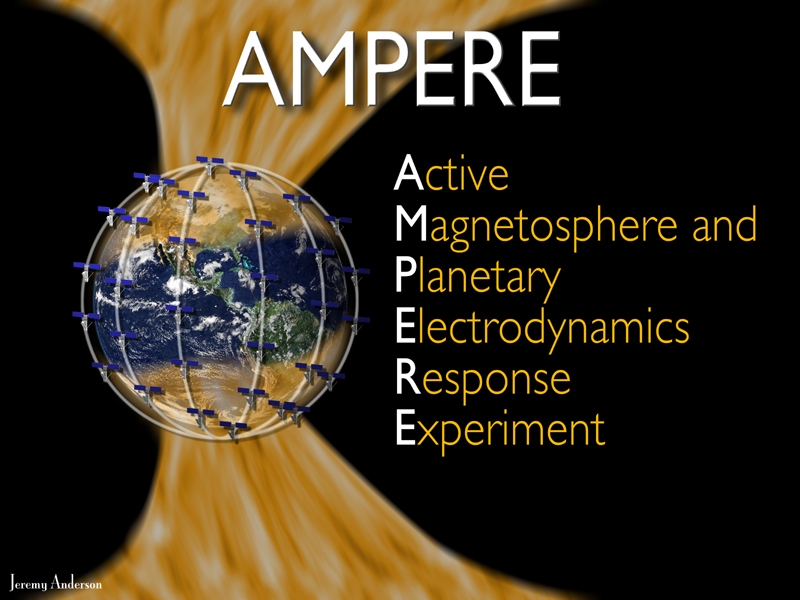Press Release
APL-Led Team Wins NSF Grant to Develop New Observatory for Earth's Space Environment
Mon, 07/21/2008 - 12:33
The Johns Hopkins University Applied Physics Laboratory (APL) in Laurel, Md., has been awarded a major grant of $4 million by the National Science Foundation (NSF) for an experiment that will allow, for the first time, global and real-time space weather observations of near-Earth space.
The Active Magnetosphere and Planetary Electrodynamics Response Experiment (AMPERE) will use the Iridium constellation of communications satellites to measure the electric currents that link Earth's atmosphere and space. By measuring this key component of the space weather system, AMPERE will allow 24/7 tracking of Earth's response to supersonic blasts of plasma ejected from the sun. AMPERE will also enable advances in theories and simulations that could transform our understanding of Earth's space environment, and improve space weather forecasting.
For the project, APL is collaborating with Iridium Satellite LLC and the Boeing Company to leverage the unique capabilities and orbits of the 66 Iridium satellites, which provide global telephone and data services. New software that will be uploaded as part of the experiment represents the first-ever "secondary payload application" for the constellation.
The satellites already detect the electric currents through which they pass, but the software developed under the NSF grant will increase the number of measurements 100-fold, enabling a quantum advance in our ability to observe the near-Earth space environment.
"Earth's space environment can completely reconfigure in as little as 30 minutes," says APL's Brian J. Anderson, principal investigator for AMPERE. "With this new ability to continually monitor these electric currents, we will be able to track the transformations of our planet's space environment for the first time and thereby gain a new understanding of how Earth reacts to the sun."
More than 800 satellites orbit Earth today, forming the backbone of many modern communications and navigation systems. Storms in our space environment driven by solar disturbances can damage these satellites and can also pose dangers to astronauts, high-altitude aircraft and electric power grids.
During geomagnetic storms, the electric currents AMPERE will observe can exceed 10 million amperes—one million times what household wiring can handle—and deliver up to a terra-watt of power to the upper reaches of the atmosphere, the ionosphere and thermosphere. A typical power plant is designed to deliver one thousandth that amount, about one gigawatt of power.
This energy input causes a variety of harmful effects including: atmospheric heating that changes the orbits of satellites nearest Earth; ionospheric disturbances that disrupt radio communications and corrupt GPS navigation systems; spacecraft charging, which damages electrical systems; and, down on the ground, the energy can induce currents that can destroy transformers and stress generators, causing power grid disruptions and even major blackouts. The currents AMPERE will measure are also closely linked to enhanced radiation levels in space, posing risks to astronauts and spacecraft, and to plasma charging events that degrade high-altitude spacecraft.
"Presently, we do not have enough satellites making these measurements," says Anderson. "It's like trying to understand a hurricane with only a few weather stations measuring temperature. AMPERE will give us the first-ever global, real-time picture of what's really happening during these dynamic space-weather storms."
The data collected by AMPERE will complement other research efforts that seek to understand Earth's magnetic field, or magnetosphere, and the ionosphere and thermosphere. AMPERE will produce real-time dynamic maps of the electric currents, which will be available to researchers and the general public.
The Boeing Company (www.boeing.com) is a leading aerospace company and the largest manufacturer of commercial jetliners and military aircraft combined. Additionally, Boeing designs and manufactures rotorcraft, electronic and defense systems, missiles, satellites, launch vehicles and advanced information and communication systems. Boeing has customers in more than 90 countries around the world and is one of the largest U.S. exporters in terms of sales.
Iridium Satellite LLC (www.iridium.com) is the only mobile satellite services (MSS) company offering gap-free, pole-to-pole coverage over the entire globe. Iridium's constellation of 66 low-earth orbiting (LEO), cross-linked satellites (and multiple in-orbit spares) provides critical voice and data services for areas not served by other communication networks. Iridium serves commercial markets through a worldwide network of hundreds of distributors, and also provides services to the U.S. Department of Defense and other U.S. and international government agencies. The company is headquartered in Bethesda, Md. and is privately held.
The AMPERE Web site can be found at ampere.jhuapl.edu.
